#gold torc
Explore tagged Tumblr posts
Text
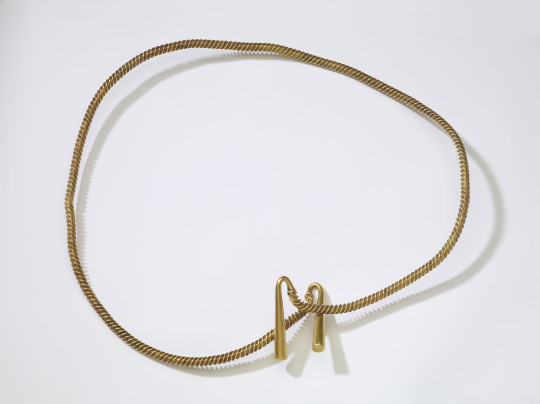
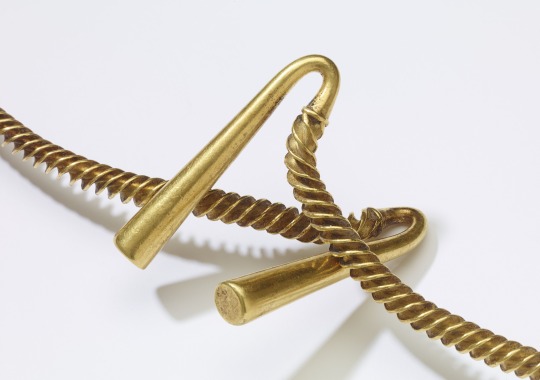
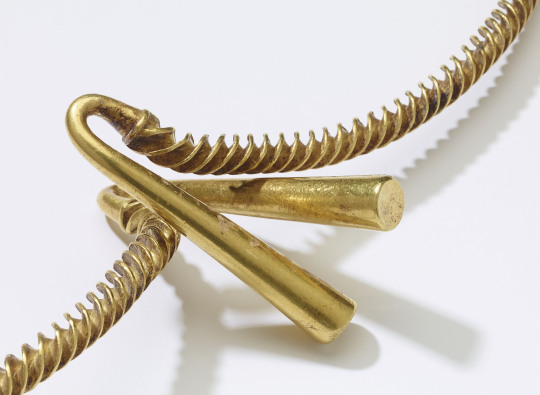
Massive Bronze Age Gold Torc Stolen From Ely Museum
Curators are "devastated" after gold objects dating back 3,000 years to the Bronze Age were stolen from a museum.
A gold torc and a gold bracelet were stolen during a break-in at Ely Museum on Tuesday.
The museum acquired the torc, valued at £220,000, in 2017 using grants and donations and it said the loss was a "huge blow".
Cambridgeshire Police said it was looking for two suspects on e-scooters who were believed to be involved in the burglary.
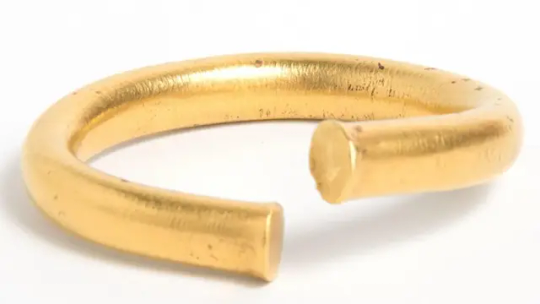
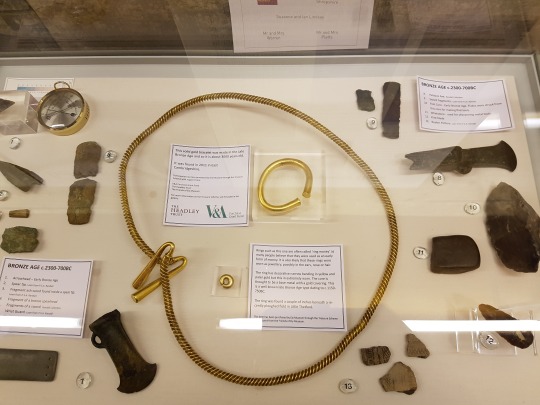
'Cannot be replaced'
Elie Hughes, a museum curator, said: "We are devastated by the loss to the museum and to the local heritage of the region.
"It is a huge blow after the incredible support from the community in acquiring the torc in 2017.
"As a culturally significant object, it cannot be replaced. Our priority now is working with the police to locate the stolen objects."
Both items were found in East Cambridgeshire by metal detectorists.
The torc, found in a ploughed field, is regarded as the best found in England in more than a century as it is larger than many other examples and made of 730g (1lb 10oz) of almost pure gold.
Det Insp Kiri Mazur said: "The theft of these items is despicable and we are focused on identifying the offenders, tracing the items, and returning them to their rightful place.
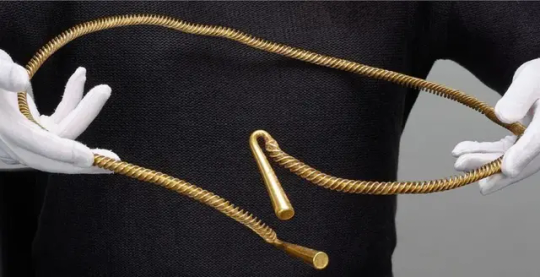
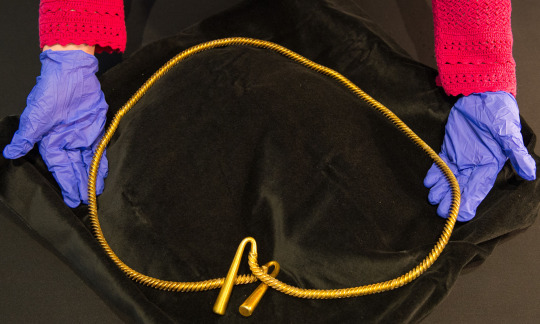
"We are working closely with staff at Ely Museum to follow all lines of inquiry.
“I am very keen to hear from anyone who may be able to provide information or saw two people on e-scooters who were in the vicinity the museum, car park and pedestrian walkways at the back of the museum, the council offices and the Grange Car Park, between 12am and 2am [on Tuesday].”
By Harriet Heywood.
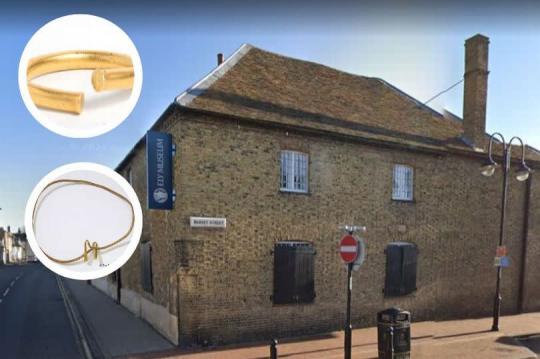
#Massive Bronze Age Gold Torc Stolen From Ely Museum#Ely Museum#gold#gold jewelry#gold torc#gold bracelet#ancient gold#ancient artifacts#metal detecting#stolen#stolen art#looted art#archeology#archeolgst#history#history news#ancient history#ancient culture#ancient civilizations#bronze age#ancient art
26 notes
·
View notes
Text




'The Snettisham Great Torc', Iron Age Torc, The British Museum, London
This torc was discovered in 1950, in a field near the village of Snettisham. The site is on the north-west coast of Norfolk, overlooking the Wash.
This torc is one of the most elaborate golden objects from the ancient world. It is made from an alloy of gold, silver and copper, and weighs over 1 kg. The neck-ring is made from 64 wires in eight separate coils. The ends are elaborately decorated with swirling motifs.
The torc was probably buried around 50 BCE.
#ice age#bronze age#stone age#iron age#prehistoric#prehistory#neolithic#mesolithic#paleolithic#archaeology#electrum#gold#design#torc#jewellery#ancient crafts#ancient living#ancient cultures#status#British Museum
202 notes
·
View notes
Text
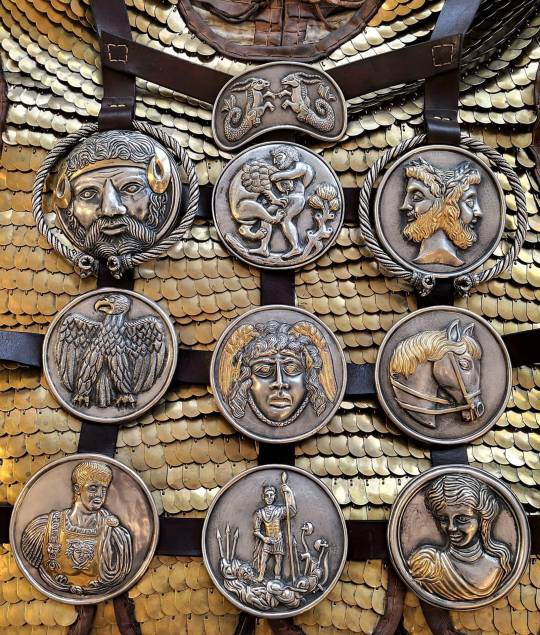
A recreated Centurion's Phalarae harness, 1st Century AD for Legio XXI Rapax. It would be attached to his Lorica Squamata it holds 10 discs for bravery and service. The two discs upper left (the god Jupiter) and far right (god Janus) are attached to two silver torcs, added bravery awards. They could be small or large, gold or silver, flat or heavily 3D to make them more impressive and visible. Between the two top discs is Herac(k)les battling the Nemean Lion and the middle disc is the Gorgon Medusa (common central motif on Roman high officer's Lorica Musculata for hundreds of years) Above Medusa are two mythical Roman Capricorns that are linked to Augustus, and bottom left is the Emperor Nero. The middle bottom is the Emperor Tiberius standing over his dead enemies. Above Nero, appropriately is a mighty Roman Aquila (eagle) spreading its wings - the very essence of Roma herself. This is one of the most perfect harnesses I have seen, not to over the top but it clearly warns all viewers who these men are.
Text by Dan's Roman History
Photo: Cezary Wyszynski
427 notes
·
View notes
Photo

Celtic Coinage
The coinage of the ancient Celts, minted from the early 3rd century BCE to the 1st century CE, at first imitated Greek and then Roman coins. Celtic engravers then soon developed their own unique style, creating distinctive coins with depictions of stylised horses, abstract shapes, and the portraits of Celtic chiefs. Not being part of a wider political and economic entity like the Roman Empire, gold, silver, and bronze Celtic coins were rarely used for interregional trade but were, rather, used to buy and exchange goods locally and to spread imagery of rulers, tribes, and the ancient Celtic religion. Finally, coins were frequently buried in large hoards as part of votive rituals.
The Function of Celtic Coinage
An enormous number of Celtic coins have been found in burials and as part of ritual treasure hoards across Europe. Some hoards contained as many as 10,000 coins. Celtic coins were used for a variety of reasons. They were, as one would expect, used as a currency to acquire goods locally but coins were primarily used as a more convenient replacement for other high-value goods which had previously been used in a barter system. Coins were also offered as diplomatic gifts and perhaps given as tribute to more powerful neighbouring rulers.
Coins were also minted for prestige reasons: to demonstrate the wealth and sophistication of a particular chief and to spread their likeness amongst the people they ruled. Coins were sometimes dispensed by chiefs to their people on special occasions as a demonstration of their success and generosity. It is for this reason, perhaps, that the minting of Celtic coins was so sporadic: only when a ruler needed extra legitimacy for their rule were new coins minted.
Although coins provided artists with a new medium to show off their skills, an unexpected consequence of their introduction on wider ancient Celtic art is here summarised by the historians J. Farley and F. Hunter:
The spread of coinage coincided with a rapid decline in the production of unique and ornately decorated objects: the shields, weapons and torcs that were both symbols of status and power, and the canvases for earlier Celtic art. As small, mass produced objects, coins are undoubtedly less impressive than the imposing metalwork that had gone before but they offered a new kind of impact. Rapid manufacture and portability allowed powerful images, political messages, and a newly transformed stock of Celtic art to be transmitted to a wider audience than ever before.
(110)
Celtic coins were rarely used in interregional trade since, unlike say in the Roman Empire, Celtic Europe was made up of many different tribal groups and the coinage of one had no value in another except for the weight of precious metal. It is for this reason that small scales have turned up everywhere in the archaeological record, needed to assess the real value of coins which were used in trade. A consequence of the necessity for a coin to have a real value as opposed to a face value was that should any chief be tempted to debase the metal in their coinage (and some did), they would find it of little use outside their own territory.
Finally, coins were frequently buried in hoards. However, this was not always a mere ‘bank in the ground’ strategy but likely involved some sort of specific ritual and was done as a votive offering to Celtic deities. Such deposits were added to over a period of many years, sometimes several decades, and were often divided into multiple hoards in the same vicinity. The site of Hallaton in England, for example, has been excavated by archaeologists, and they discovered over 5,000 coins buried in 16 different places. Nearby were remains of ritual animal sacrifices, further pointing to a religious significance to the burial of these coins.
Continue reading...
83 notes
·
View notes
Text

Celtic Gold Phalera with Cernunnos, 1st Century BC
Cernunnos is the conventional name given in Celtic studies to depictions of the “horned god” of Celtic polytheism. The name itself is only attested once, on the 1st-century Pillar of the Boatmen, but depictions of a horned or antlered figure, often seated cross-legged and often associated with animals and holding or wearing torcs, are known from other instances.
Nothing is known about the god from literary sources, and details about his name, his cult or his significance in Celtic religion are unknown. Speculative interpretations.
56 notes
·
View notes
Text
Cernunnos Deep Dive
This was a requested deep dive on Hermes, you can request a deep dive on my ko-fi for $5!

Unfortunately not much is known historically about Cernunnos. Scholars seem certain, however, that he was an ancient Gaulish deity.
Let’s get to know this elusive deity!
Parents and Siblings
No attested parents or siblings
Lovers or Partners
No attested partners
Children
No attested children
Epithets
As far as we know, no ancient or historical epithets of Cernunnos have made it through the passage of time. That said, we have some epithets given to him from more modern times.
Lord of Beasts (Anne Ross)
Patron of Prosperity (Anne Ross)
Lord of Animals (Proinsias MacCana)
Lord of Living Beings (David Rankin)
Lord of Beasts and Fecundity (Miranda Green)
The Horned God*
More potential epithets listed in Jess South’s text referenced below.
Keeper of riches
God under the earth
Antlered serpent, Horned serpent
Clearer of paths
Sitter-at-the-crossroads
Sitter-between
Liminal one
God undying
Notes
*In depictions of Cernunnos, his head is notably adorbed with antlers, not horns. This epithet is also the name of the two primary deities of traditional Wicca. It is also shared among many other deities who are depicted with horns.
The name Cernunnos has appeared only once throughout history—on the Pillar of the Boatmen.
Though he is sometimes known as a god of animals or beast, Ceisiwr Serith (or David Fickett-Wilbar) makes the case that although he is depicted on the Gundestrup Cauldron surrounded by animals, only two are looking at Cernunnos, the stag and the dog. Plus there are other deities present on the cauldron.
Cernunnos’ depiction as a “Lord of the Wild” likely comes from his imagery, a man often sitting cross legged and with antlers on his head. This may denote a more spiritual, natural theme for Cernunnos. However, he is not depicted with vegetation or plants
Often depicted wearing a torc, Cernunnos is sometimes considered a god of wealth or fortune. Torcs were known to be a sign of wealth.
He is also seen as a cthonic deity or a psychopomp. Jo Forest makes the case that due to his imagery with snakes—creatures often associated with the underworld—and his relation to the ram due to the ram's horn. Rams were often sacrifices in ancient Indo-European practices.
Cernunnos is likely not a fertility god. This idea may come from his conflation with the Wiccan Horned God, as mentioned earlier.
Cernunnos has been considered to be related to masculinity, but this is also likely due to the conflation with Wicca’s Horned God.
Depictions of Cernunnos with domesticated and prey animals may suggest him being a god of hunting or hunters.
Jess South makes the case further for Cernunnos’ associations with liminality. Between man and animal; hunter and hunted; life and death.
This also points to him possibly being a god of balance or dualities. See Jess South’s “Liminality and Dualities, or “Paired Opposites”’ portion in the text referenced below for more.
Modern Deity Work
Not much is known about Cernunnos or how he was worshipped in the past, but any of the more historically-attested correspondences will have an explanation with them!
Correspondences
Rocks/Stone/Crystals
Gold, silver, copper, iron, and bronze (torcs were made of these metals)
Herbs/Plants
Ferns
Oak
Mushrooms
Mosses
The following plants are associated with liminality, trancework, or hedge-crossing which is why I have included them. Do not consume a plant that you’re unfamiliar with, and be careful touching them. Keep them out of reach of children and pets.
Foxglove
Mugwort
Nightshades
Animals
Stag (depicted looking at him on the Gundestrup cauldron and the silver bowl from Lyons, also he is often depicted with antlers like a stag)
Dog (depicted looking at him on the Gundestrup cauldron and the silver bowl from Lyons)
Ram-horned snake (often depicted holding a snake)
Symbols
Torc (often depicted wearing and holding torcs)
Snake
Antlers
Offerings
Torcs
Imagery of the animals associated with him
Wine
Beer
Antlers
Food
Bones
Feathers
Coins
Acts of Devotion
Explore liminality--what this means is up to you!
Take time to appreciate the balance between man and nature, see how you can participate.
Go hunting--this isn't required but if you're up for it, go for it! Just make sure to do so in an ethical way.
Meditate in the forest, or forest bathe, or just hang out in a woodsy /natural area
Quite frankly, since he is a god heavily associated with liminality, it may be a good idea to test the waters with gender expression!
Read up on him, the following section has a lot of really interesting takes and history on Cernunnos!
Get into cthonic magic
Consider learning more about hedge witchery
References and Further Reading
Cernunnos; An In-Depth Look by Jo Forest
Cernunnos: Origin and Transformation of a Celtic Divinity
Cernunnos: Looking a Different Way by David Fickett-Wilbar
Not Your Mother’s Horned God: The Cernunnos Primer by Jess South (“thebloodybones”)
Britannica
Wikipedia
Mythopedia
ΚΑΡΝΟΝΟΥ: to CARNONOS
127 notes
·
View notes
Text
Captive, Captivating
into the steddie-verse, omegaverse, intense dubcon, we’re all in the same imperial rome/war prize gutter together, mdni 🔞
As the emperor’s brother, Geta should not be on this northern campaign, but he is curious of these barbarians and how they live without the bounty of the mediterranean. His tent is rather well-appointed besides, his own personal guard and servants setting up his bed, the furs and chairs, each time they move. He even has a small brazier to heat the tent against the cold night.


That doesn’t make his presence anymore reasonable, but as the only member of the imperial family amongst the generals and their legions, it means the greatest of the war prizes belong to him. Thus far, he has accumulated a beautifully made brooch inlaid with garnets, several gold torcs, a pair of fine horses, and one prince to ransom back to his father—that netted him gold and silver coins from many kingdoms, as well as a herd of goats.
But there hasn’t been anything new for weeks, and Geta thinks they are perhaps between barbarian kingdoms. The sun has set on another day, and he is reading over the report he is about to send back to Rome, when Junius enters the tent and makes his presence known.
“We’ve captured an intruder, your grace. Flavianus sniffed him out, and it sounds like his father is a king. Ricardius Spear-hand, if he’s to be believed.”
“And just what was the little prince up to?” Geta puts down his report, grinning. This is intriguing.
“Spilling wine urns and turning loose horses. But mostly spying. We found him outside the general’s tent. The fool rubbed himself in wild mint, but it wasn’t enough to dampen an omega’s scent.”
Geta burns hot at that, his own smoky scent blooming. He has questions, but more than that, he wants to meet this bold omega prince. “Bring him to me.”
“At once, your grace.”
Junius is barely gone a minute, clearly anticipating this request, bringing in a growling young man, stripped down to a loincloth to ensure he carries no weapons, his hands bound in front of him. His flesh is raised in a thousand tiny bumps at the chill of the night air, and his thick, dark hair hangs limp around his head, stringy with his own drying sweat. And his scent is sweet and yeasty like the honey beer the northern barbarians drink in place of wine.
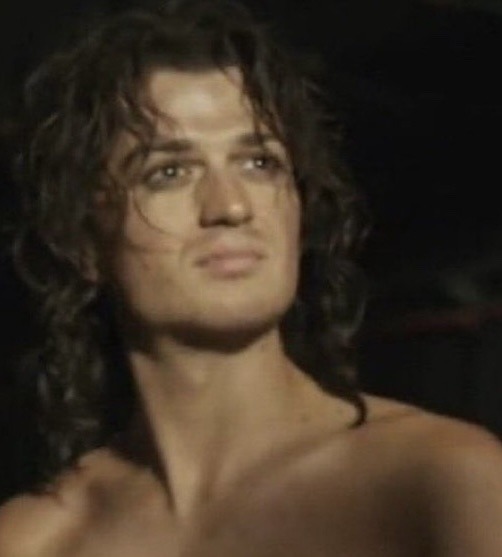
“He claims to be Prince Stephanos, your grace. I don’t believe we have record that he’s an omega… Other than this.”
“Why do you insist upon changing my name?” the omega asks, voice harsh with his whining little growl. Geta has heard of northerners learning Latin, but he did not expect this prince to speak it so well.
“You are Stephanos, son of Ricardius, are you not?”
The boy frowns, looks away, and waits. Junius raises a questioning brow, which Geta answers with a wave of his hand and a soft, “Leave us.”
Junius bows and backs out of the tent.
Stepping closer, Geta grips the omega by the chin, and turns his head to face him. “I asked you a question, little prince.”
His hazel eyes flash with defiance, and he bites his lip so hard it bleeds. Then he takes a breath. “I am Stepan, son of Rikhardt Spear-Handed. As my father’s eldest child, I did my duty. Please, take your soldiers and leave my people be.”
Swiping his thumb over Stepan’s lip, smearing the blood, Geta wants so badly to taste. To bite. He resists, leaning in closer and whispering, “I am not here to conquer; that is my brother’s doing. I wish only to learn and see and experience what this world has to offer. I will be your willing student, sweet Stepan, but I shall also be your master. You have bought freedom for your people.” He withdraws his thumb and sucks it into his mouth, the metallic taste of blood on his tongue, yet somehow sweeter than he expects.
The omega trembles, and Geta steps back to hive him space, eyes roving over his exposed body. His nipples are hard, pebbled along with his gooseflesh, and his small breasts are puffy, swollen like he’s near his heat.
“I will not take you tonight, so do not fear.” Geta circles him slowly, retrieving a length of soft, woven wool, and steps up behind him, arms wrapping the cloth around the omega’s shoulders. Stepan jolts at the touch, but doesn’t struggle as Geta holds him. “But you will be mine.” His right hand settles low on Stepan’s belly, presses firm. “Soon my pup will be here.” He sets his nose to the princeling’s neck, and Geta is sure he smells even sweeter as he inhales deeply. “Can tell your heat is coming, but maybe you’ll breed true before it can begin.”
He drops a single kiss over the warmth of Stepan’s mating gland, feels the flutter of his pulse. “But tonight we shall simply rest. Come, Stepan. Let’s to bed.”
🏛️🌙🌿
Stepan does not sleep that night, or if he does, it is a fitful sleep. But he has no hope of escape, his captor holding him tight from behind, trapping him in the bed beneath sheets softer than he has ever felt. And surely, the tent is well guarded.
He’s spent enough time awake, looking around the tent for anything he can use, either to incapacitate the roman, or if worst comes to worst…
He hopes it does not come to that.
Strong arms squeeze around his middle, a forehead presses into his shoulder, as the alpha wakes with a sighing hum. “Good morning, little prince.”
The mere thought of replying cordially locks his throat, but Stepan swallows and decides to get it over with; the words will only get easier with practice. “Did you sleep well, Dominus?”
“Best I’ve slept since coming north. How you can sleep in this cold I’ll never understand.”
“It is summer, Dominus?” How soft the romans must be to find a summer night cold. He wonders how his new master would handle traveling through the snow in winter.
“Yes, summer! The air should be hot and leave your skin sticky long after the sun sets!” His hold on Stepan changes, no longer a harsh grip, but one arm loose around his waist, the other snaking up so his hand cups one of Stepan’s breasts. “This is the first time I haven’t woken shivering.” He squeezes, kneading the soft flesh beneath his fingers, then pulls back just enough to grip the nipple between finger and thumb.
He pinches and pulls, and Stepan hates that it feels good. Stifling a moan, he brings his still loosely-bound hands up to grab the alpha’s wrist. “Dominus?”
“You are just so sweet and so warm,” he growls low in Stepan’s ear. Hand spread wide across his chest, moving with each shallow breath, he changes course. No orders to get on his hands and knees, no spreading of his legs, no hand pushing aside the cloth over his sex. Instead, he murmurs, “We shall meet with your father and his counsel today, to talk the terms of peace.”
“The terms being me. In your bed.”
“The terms being you. At my side. I am not looking for a mere bedwarmer, sweet Stepan.” He contradicts this entirely by kissing the side of his neck, sucking the salt from his skin. “You took a risk. It failed you, but now you have learned. And with my guidance you will learn more.”
Stepan’s mind races. He had been certain thot at best he would be a concubine; an omega to give this roman enough bastards to feel good about his virility when his high-born wife managed a sickly pup or two. He no longer thinks that is what his master has in mind. “Dominus?” he asks softly, wishing he could see his eyes now, even in the low light it would tell him more of what he means.
“Rome is a dangerous place. You and I shall need all our cunning when the army returns at the end of this campaign.” He relaxes his grip, finally, and rolls away just enough to make room for Stepan to roll onto his back.
His master smiles, wolf-like, and places a hand back over Stepan’s breastbone, holding him down with the lightest touch as he stares into his eyes. “Do not worry, my sweet omega, I’ll do everything in my power to protect you and our pups.”
“What pups, Dominus? We have done nothing to make any.” Stepan shivers under his dark gaze. “Besides, how can you be certain you won’t grow bored with me in a month’s time?”
“It will take far more than a month to do everything I want with you. Do not worry about my growing bored.” He leans down and takes a dusky nipple into his mouth, biting at the bud with gentled teeth.
Stepan pants, watches as the alpha removes his mouth, tongue lapping at tender skin. A hand reaches for his, working him free from the soft bonds at his wrists and casting the fabric aside. “But you are right; we’ve done nothing to make pups.” He reaches for the ties at Stepan’s waist, pulls them loose, and pushes the fabric aside. “We ought to get started now.”
He pushes off his own coverings, but Stepan does not look. If he doesn’t look, his body cannot lock up at the thought of the intrusion. He can relax enough to keep it from hurting. To keep from being torn apart.
His master has other plans for their coupling, catching up Stepan’s hand and wrapping it around the alpha’s half-hard cock. He guides Stepan in rubbing him to full hardness, tiny moans and soft praise falling from his lips, breath hot against his skin. “Good omega. Yes, touch just like that.”
Finally ready, he boxes Stepan in with his arms, and ruts first against his cunt, just enough wetness there to ease his way and coat his cock. “Even scared you smell so sweet,” he whispers, dipping to nose at his mating gland. “So sweet.” He shifts his hips, and the head of his cock nudges against Stepan’s entrance. He only waits a moment, long enough to whisper, “Deep breaths, my omega,” before thrusting forward.
Stepan gasps, is sure he is being split apart, and moans, “Dominus, please…”
“It will only hurt a little while. Your body will learn.” He stays buried inside, watching Stepan breathe, waiting for him to calm. Only then does he move his hips, picking up speed until he spills hot, his knot tying them fast.
Gathering Stepan to him, he rolls onto his side and holds him close, bringing one of Stepan’s legs over his hip, which opens his cunt enough to relieve a little bit of the pressure there. “Rest, my sweet. Once we untie, we shall bathe and eat. Then this afternoon we shall treat with your father.”
Stepan nods. He has done his duty. His people shall have peace.
part 2
#omegaverse#fanfiction#ficlet#steddie#not really but still steddie#gladiator 2#alpha geta#omega war prize steve
62 notes
·
View notes
Text
Fern's Cernunnos Deep Dive pt. 2

Aspects
Animals
The most obvious on here is of course Cernunnos' antlers. It ties him to the stag, and through this to the realm of animals. However, this is not the only evidence we have. Most who have written about Cernunnos, like Green, Ross, MacCana, and Strutynski, all name him "Lord of Beasts" or a variation on this theme. On the Gundestrup Cauldron, one of the most iconic images we have of Cernunnos, he is surrounded by animals. The depiction found of him in Reims show a rat on his antlers, and a stag and bull at his feet.
Forest and Hunting
From the depiction of animals, especially those of the stag and the boar, it is a natural step to associate Cernunnos with the forest. The stag is known in different European cultures as the King of the Forest, so an antlered God being a Lord of King of the forests and all that lives within, makes sense. On the Grundestup Cauldron we see prey animals, such as the stag, the fish, and the bull. As well as animals used for hunting, like the dog. This had lead many to believe that he is also the God of the Hunt, and even, through an admittedly flimsy connection with Herne, as the leader of the Wild Hunt. David Fickett-Willbar posits that there is not enough evidence of actual hunting to support Cernunnos as a Lord of the Hunt. On none of the depictions there are actual hunting attributes seen, only the dog, which in Celtic and Gallo-Roman depictions more often symbolized the underworld or Otherworld than hunting. That being said, in my experience Cernunnos is definitely a God of the hunt, being both the stag (the hunted) and the wolf (the hunter).
Cycle of Life and Death
Because of his aspect of both Hunter and Hunted, and his tie to animals, I also associate him with the cycle of life and death. Birth, to adulthood, to death, to decay, to rebirth. The cycle of nature, in animal and in plant life. A thing that is easy to observe in the deep forests.
Chthonic God
This ties into the cyclic aspect of life, but there are more things that tie Cernunnos to "within the earth" or the Underworld. He is often depicted with a horned serpent, which according to Marian Green depicts the calm nature of Cernunnos. However, in Greek myth we also have a ram-horned serpent called the Cerastes. This serpent would burrow itself within the earth, until only the two (or four) horns were visible. There it would wait for its prey to come by, leap out, and devour it. Because of the burrowing the Cerastes, and through it the horned serpent, are also tied to the Underworld, to which it was thought he was closer. The dog or hound is also often found on images of Cernunnos. Not just a symbol of the Hunt, the dog was also a symbol of the Underworld in the Germanic world.
Wealth
Another attribute that is carried often by Cernunnos is the torc. A torc is a neck ring, often made from bronze or gold. It is seen as a symbol of status, of divinity, and of material wealth. Later the torc was replaced with a bag of bowl of coins, another symbol of material wealth. Oxen were also a sign of wealth that appear on Cernunnos' engravings, also tying him to the wealth of towns and agriculture, rather than the forests. This is an aspect of Cernunnos that does not appear to me often, personally, but I do see the association.
Liminality
The liminal, the in between. Often we see Cernunnos depicted with a horned snake in his left hand, the snake meaning death and the left hand having negative connotations, and the torc in his right hand, the torc meaning wealth and the right hand a positive sign. Cernunnos places himself in the center by holding his hands at shoulder height. On the depiction of Cernunnos found in Reims we see the stag and the bull. Both symbols of wealth, but where cattle is a sign of domesticated wealth, the stag is a sign of the wealth of the wild. And once again, Cernunnos is depicted in the center. On the Grundestup Cauldron there are dogs, a sign of the hunter and death, and stag, a sign of the hunted and life, opposite of each other, both facing Cernunnos. Which brings us to the tricephalous, a Gaulic representation that is found for several Gods, amongst which Cernunnos. It is a figure with three heads, one facing forward, and the others facing to away from the center to the sides. Many interpretations can be made about facing the past and the future, death and life, the negative and the positive. But all places the center head, which is often most detailed or bigger than the others, in a more important position. Two statues of Cernunnos found in Atun and Condat, both are tricephalous and have removable antlers. On a personal note have also experienced Cernunnos as liminal when it comes to gender. He has helped me see my own liminality, and I often see him with different mixes of primary and secondary sex characteristics. Other non-binary devotees of Cernunnos have expressed similar experiences.
And with that we have reached UPG territory. The next ones are purely from my personal experience with Cernunnos, and, as far as I know, have no basis in the historic evidence that has been found.
the Otherworld
To me, Cernunnos is also a King of the Fae. The deep wild woods are reminiscent to the realm of the Wild Fae, and often entrances to this realm can be found there. As said above I associate him with the Wild Hunt, a procession of beings racing through the skies at certain times of the year. Sometimes these are beasts, sometimes these are fae, and sometimes these are witches. (Perchta's procession is children, but that is specific to her.) In the path that I walk witches and fae are very closely related, and through this Cernunnos is also seen as the Witch King. Teaching magic and journeying to and from other realms.
Bonfires
Another personal association. To me Cernunnos is closely tied to music, and to ecstatic dance, often around a bonfire. I have had several instances of dancing in front of a fire, and suddenly seeing myself on top of a mountain, a huge bonfire in front of me, and other witches and devotees sharing this moment of dance and passion. There is also the Dutch festival of Castlefest, which is a pagan- and fantasy festival. On Saturday they burn a wicker creature, which holds offerings made by the visitors. My offering is always for Cernunnos, whose presence I feel strongly at this festival. So this is another reason for this personal association.
[Masterpost]
40 notes
·
View notes
Text

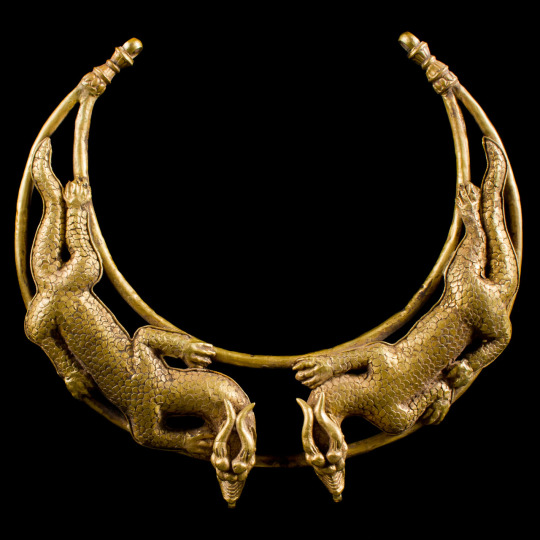
Scythian Gold Double Dragon Torc Necklace from Central Asia (200 BC). "After extending their country Scythia into more western lands beyond the Black Sea, many Scythians migrated into Europe and the Middle Eastern lands as far as Egypt while leaving new Dragon Families and Courts in their wake. The various tribes of Scythians included the Royal Scythians as well as the Ossetians, Pashtuns, Sarmatians, Kazakhs and Yakuts. Once in Europe, these Scythian tribes spread over much of their new continent, eventually separating into the Hungarians, Romanians, the Serbians, the Croatians of the south, as well as the Germans, Picts and Gaels of the north." From Mark Amaru Pinkham's "An Initiates Guide to the Path of the Dragon
74 notes
·
View notes
Note
Ainda sem entender pq essas gringas aqui estão bravas chega até ser engraçado. Tem uma querida que comenta sobre o barça e a seleção espanhola que não reconhece o quanto elas foram péssimas 😂
O time delas jogo o pior futebol, as jogadoras da espanha falam um monte de merda depois da partida e a gente tem que aguentar calado? Ah me poupe, esses europeus sempre se achando superior às seleções sul-americanas...
Bom, há quem diga que a negação é um dos primeiros estágios do luto.
Mais cedo eu vi uma coisa no Twitter que pra mim fez muito sentido, vou tentar resumir aqui.
Enquanto nós estávamos em uma má fase (literalmente semanas atrás) correndo risco de ficar fora dos Jogos Olímpicos, ou até mesmo no começo do ano quando disputamos a Gold Cup e a She Belives lá nos EUA e apesar de apresentar um bom futebol ainda saímos perdendo, todo mundo gostava da gente. Era sempre o mesmo papo de: "Ah, o Brasil merece mais!", "A Marta merece encerrar a carreira internacional com um título", "É triste ver a atual fase da Seleção Brasileira", etc, etc.
Mas agora que aparentemente encontramos o nosso futebol e apesar de eu discordar com algumas coisas (tal como a cera excessiva da Lorena pro Arthur arrumar a bagunça no campo) e principalmente depois de derrotar essas duas grandes potências do futebol feminino, o papo é outro, que nós jogamos sujo, que não jogamos futebol, como a Hermoso falou, que somos arrogantes, desrespeitosas, antidesportivas, e por aí vai.
Esse tipo de gente não entende a verdadeira essência do futebol, o quanto ele impacta de verdade não só a vida das jogadoras que vestem as nossas cores, mas a vida de quem torce, de quem tá conhecendo agora, das meninas e meninos que sonham em jogar futebol profissionalmente. Como os momentos de gritaria e provocação em campo são um desabafo, uma resposta a quem duvidou, desdenhou e até mesmo provocou elas anteriormente.
E se você parar para pensar, não é muito diferente do que rolou com a Argentina na Copa de 2022.
(Sim, a situação tá tão feia que eu vou ter que sair em defesa dos hermanos)
Apesar de tudo, eles se mostraram obviamente superiores às demais equipes naquela Copa, fizeram a maior final de uma Copa do Mundo (pelo menos a melhor que meus olhos viram nos meus quase 20 anos de vida), ganharam merecidamente nos pênaltis e lembraram o mundo de uma coisa: Se não fosse a América do Sul, o futebol não seria aquilo que ele é hoje. Se não fosse pelos nossos jogadores saírem daqui para jogar em times europeus, o futebol jogado por eles não teria relevância ou prestígio algum porque tudo começou aqui, as rivalidades começaram aqui. Eles podem até ter inventado o futebol, mas quem sempre soube jogar ele de verdade fomos nós. O primeiro campeão da Copa do Mundo foi o Uruguai, o maior campeão é o Brasil e o último campeão é a Argentina e nos ver em campo incomoda tanto eles porquê os lembra da verdade, no final das contas, é tudo nosso.
Criticaram o Dibu Martínez pelas provocações e os atos soberbos dele na Copa, hoje criticaram as meninas do Brasil por vencerem e mostrarem força de vontade em campo.
Não sou a pessoa mais religiosa do mundo, mas concordo com algo que a Lorena falou na entrevista pós-jogo para a CazéTV, nem tudo acontece quando e como a gente quer, nada é no nosso tempo, mas sim no tempo de Deus. O amanhã só a ele pertence.
Apesar de tudo é muito importante que a gente mantenha os dois pés no chão para essa final e o mais importante de tudo, não dê bola para as opiniões alheias, por mais absurdas e incômodas que elas possam ser. No final das contas vai ser só mais uma entre tantas que já vieram e das inúmeras que ainda estão por vir.
21 notes
·
View notes
Text
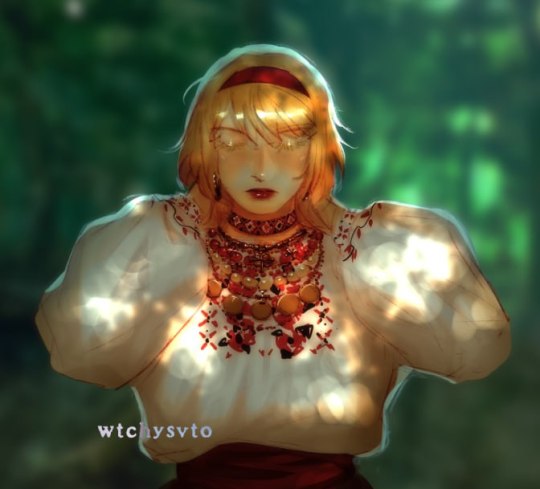
lietukr au but this time i was inspired to draw olga with some of traditional ukrainian accessories. below i tried to shortly summarize what they are so give it a read🫶
sýlianka (силянка, also pletínky/плетінки) - neck ornament made out of seed beads of various colors stringed in rows to create geometrical and floral patterns. also very similar to syliankas are gerdán and kryza
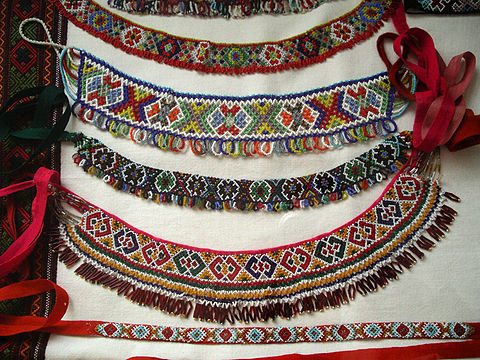
koráli (коралі, or simply corals) - a necklace made out of coral beads, the amount of rows could be anywhere from 1 to more than 25. korali are a traditional element of the national ukrainian costume. a larger amount of rows oftentimes signified of the family's wealth
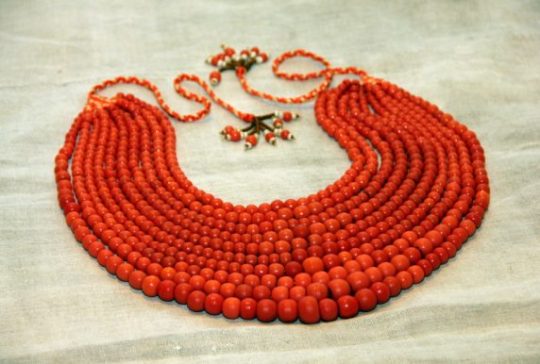
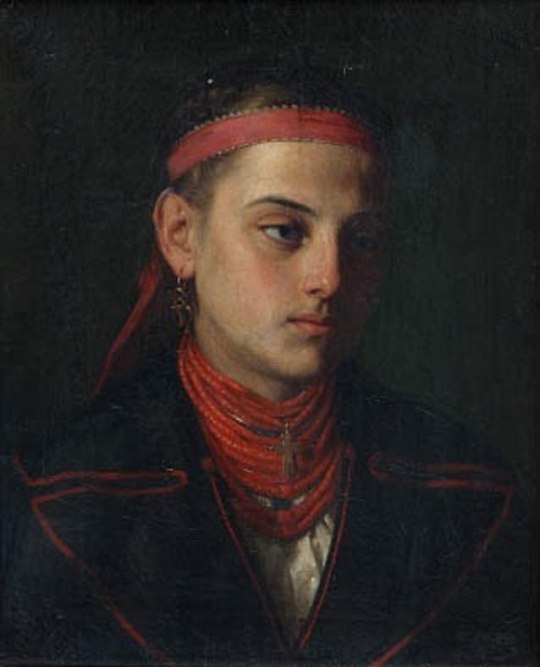
zgárda (зґарда) - a religious accessory typically of people of high status. zgardas men and women wore were different. the ones women wore were crosses out of copper or brass stringed in several rows with small spirals or tubes between them. men's zgardas were typically worn on torcs or straps
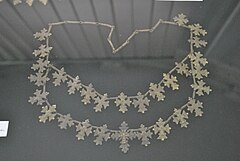
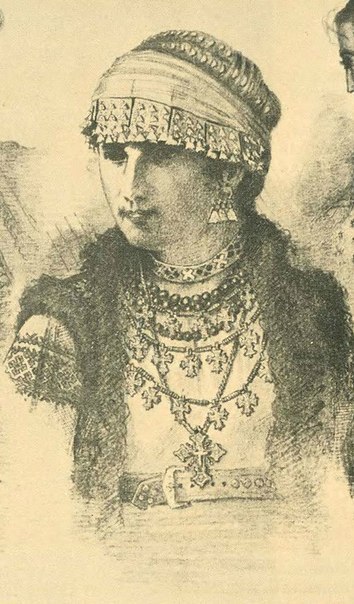
balamuty (баламути) - a necklace made with nacre beads. it was considered an expensive accessory, so it was mostly worn on weddings and was inherited by a daughter from her mother. also a traditional element of the ukrainian costume.
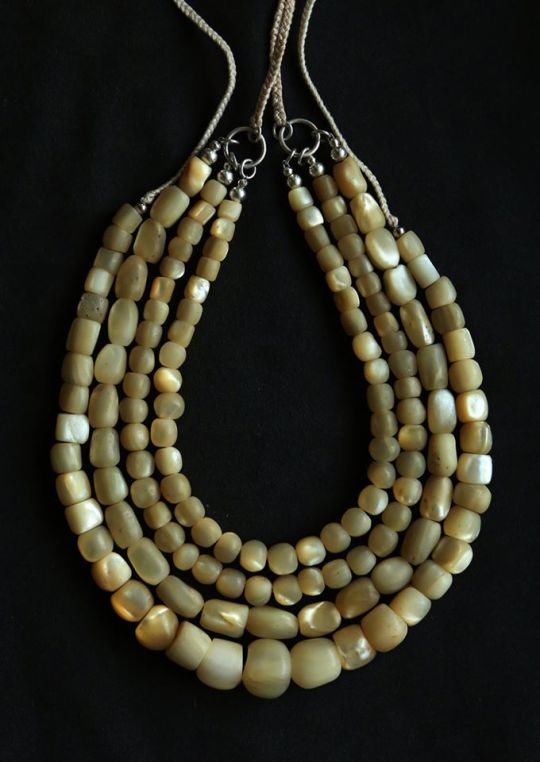
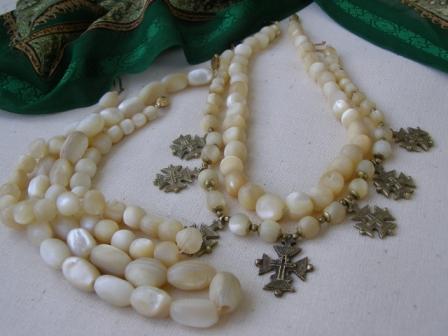
dukáty (дукати) - metal coins or medallions made into a necklace. the necklace often included beads, coral beads and crosses. sometimes made out of real gold and silver coins.
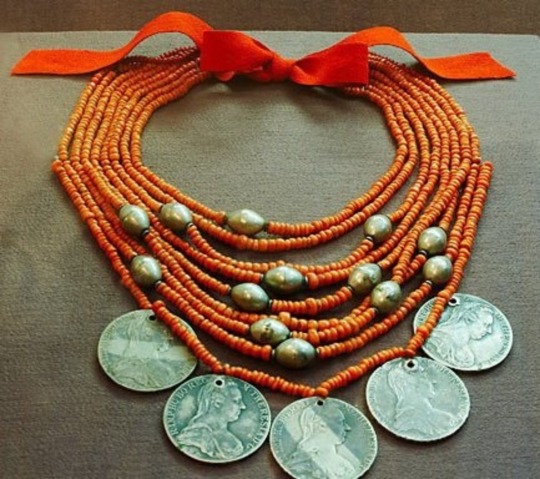
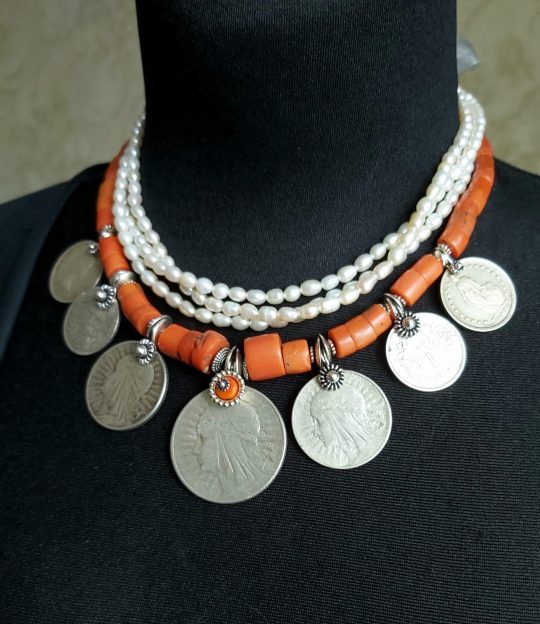
75 notes
·
View notes
Text

Scythian gold torque in the form of dragons, dated to the 2nd century BC to the 1st century AD.
Hundreds of tiny scales are individually soldered to the writhing forms of two confronted dragons on this magnificent gold torc. Thick curving horns sweep back over the long pointed ears of the rather wolf-like dragon heads. With muzzles drawn into ferocious snarls, these mighty beasts express the formidable strength of the Scythians, one of ancient Eurasia’s most powerful cultures.
23 notes
·
View notes
Text

Clevedon Iron Age Gold Torc, Clevedon, Somerset 250-75BCE, The British Museum, London
Hollow, decorated torc terminal and twisted wires from a multi- strand torc. Found in the 19th century, these may be parts of the same torc.
The terminal is ornamented with raised crescents and pellets, defined by areas of basket-weave pattern, similar to the Sedgeford and Snettisham gold torcs.
#ice age#stone age#bronze age#iron age#prehistoric#prehistory#neolithic#mesolithic#paleolithic#archaeology#wealth#gold#torc#jewellery#status#metalwork#metalworking#ancient living#ancient crafts#ancient cultures#design#curvilinear
173 notes
·
View notes
Text

A recreated Centurion's Phalarae harness attached to his Lorica Squamata it holds 10 discs for bravery and service. The two discs upper left (the god Jupiter Amon) and far right (god Janus) are attached to two silver torcs, added bravery awads. Centurions often affixed their military Paludamentum to these to high light that he had two of the prized awards, they could be small or large, gold or silver. Between the two top discs is Herac(k)les battling the Nemean Lion and the middle disc is the Gorgon Medusa (common central motif on Roman high officer's Lorica Musculata for hundreds of years) Above Medusa are two mythical Roman Capricorns that are linked to Augustus and bottom left is the Emperor Nero. The middle bottom is the Emperor Tiberius standing over his dead enemies. Above Nero, appropriately is a mighty Roman Aquila (eagle) spreading its wings - a symbol of Rome itself.
This was a very decorated group of 80 staunch warriors led by two seasoned, elite officers in the Optio and his commander, the Centurio. Exemplary on the battlefield to have been awarded all of these medals." The Mighty XXI" apart from being a walking "shing trophy case" of crazy bravery, it also oozes blatant propaganda, it positively dribbles with thematic Roman values: honoritas, gravitas, dignitas and nobilitas. When the Centurio or Optio weren't wearing it, one of the elite standard bearers was able to done it, an absolute honour in itself.
Image: Cezary Wyszynski Legio XXI Rapax.
154 notes
·
View notes
Text
I had two days of from work and managed to visit my local Gallo-Roman museum (the name is actually deceiving as they focus on the area between Neanderthals and Merovingians). Here are some of the things I saw!
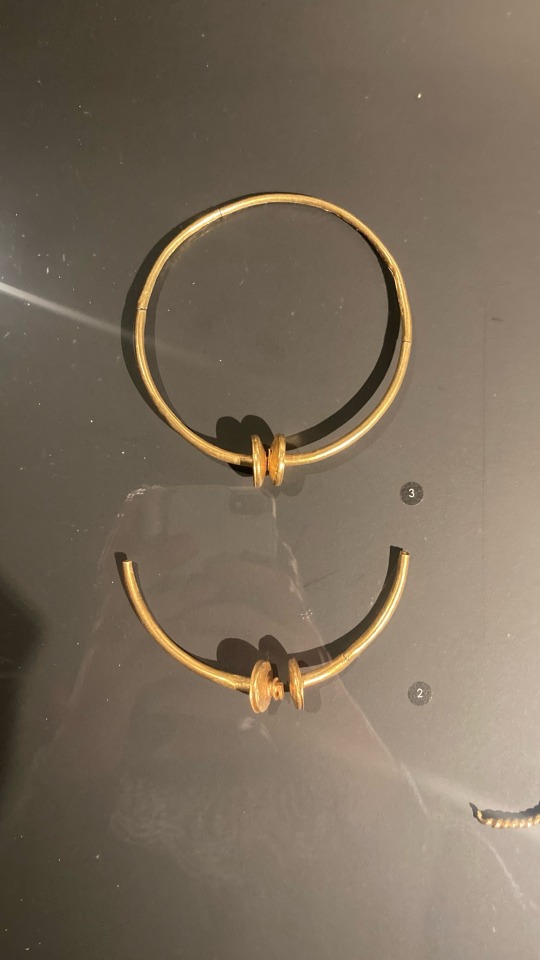


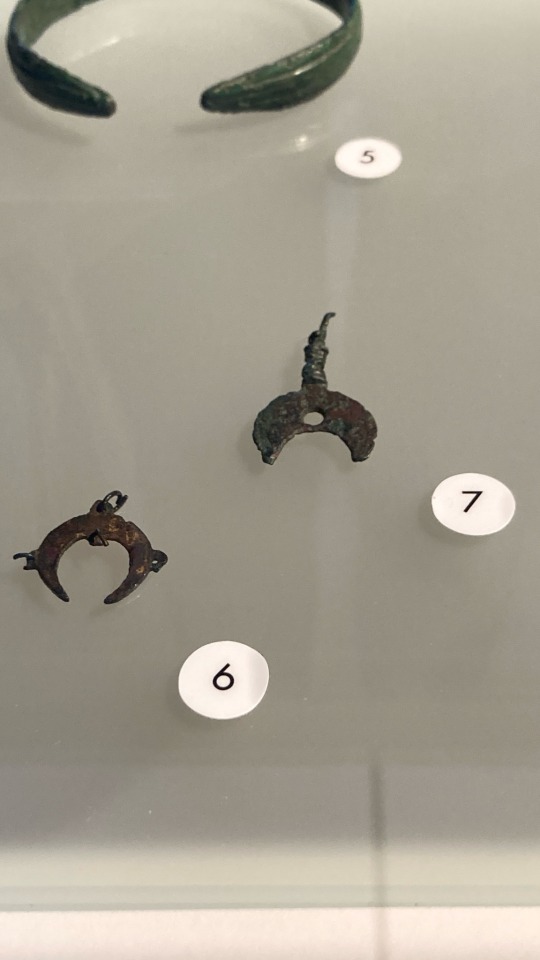


1) Gallic Torcs in gold
2) a complete Dodecahedron in bronze
3) Late Roman dress pins in bronze
4) Lunulae, moon shaped pendants, generally believed to be a lucky charm
5) a Merovingian bucket, a funerary gift
6) late Roman keys in iron
#frankish#merovingian#viking archaeology#archaeology#carolingian#charlemagne#field archaeology#viking mythology#merovingian archaeology#germanic mythology#roman archaeology#rome#ancient rome#western Roman Empire#ravenna#Gaul#gaulois#Celtic#Hallstatt#norse mythology#anglo saxon#viking#field archaeologist#frisian#odin#vikings#germanic#germanic folklore#germanic archaeology
21 notes
·
View notes
Text

The next day, the party assembled in an underground stable beneath Mirrorvision Tower. Gabrielle sat cross-legged on the floor, away from the rest of them, running a whetstone over the edge of her Sword. Torta de la Taza del bárbaro™ stood opposite her, his massive arms folded across his huge chest. Even in the dim light of the underground stable, the baby oil he’d spent hours rubbing into his thickly thewed thighs and bulging biceps glistened like he'd been crafting the night before, and a thin layer of glitter still covered his tattoos. Sir Curstaidh stood beside him, her head buried in a book called Fifty Shades of Gold: Passion and Greed in a Dwarven Logging Community. Chad stood on the other side of Sir Curstaidh, mumbling to his hoe in a way that would have been concerning if it was anyone else doing it. But farm boy heroes were whiny little brats until they finally accepted their fate and became the hero they were destined to be, so the others were just glad he was whining to his farm tool and not them.
Zoey was standing a little away from Chad, unobtrusively watching Hank and Siôn, who stood together, close by Gabrielle. The princess had never seen an elf before – they tended to keep to their forests, and there were none on her island home. But she’d heard of them, of course, and seen pictures, and the bard did not fit the mental image she had.
Siôn’s skin was tar heel blue, and her hair was as white as milk, and wound around the crown of her head in three thick braids. A fourth braid, decorated with twigs and leaves and feathers, hung behind her, dangling all the way to her clumpy black boots and ending in eight gold balls, each one about the size of an average pebble.[1] Her ears, shaped like half an apple-tree-leaf sliced along the midrib, rose up from the sides of her head to sharp points. The helix of each held a series of small gold hoops. She had another hoop, this one in the left side of her nose, and a bar through the end of each slender black-dyed eyebrow. Her eyes were as yellow as sunflower petals, and just as expressive.
The black tights she wore had been ripped in so many places the majority of her legs were uncovered, so saying she wore tights gives entirely the wrong impression. Those tights rose into ragged denim hotpants that were cut to crotch level, and sat higher on her hips. Several silver chains hung from her belt on one side, dangling down past the bottom of her shorts before curving back up. Her belly was bare, a blue stone glinting in her bellybutton and the bottom of a tattoo, scales weighing a heart and feather, to the right of the stone. Her black t-shirt, the ragged edge showing that she’d cut it above belly level herself, bore the legend Exposure Kills in white blockish letters. She had a triple strand gold torc around her neck, and gold rings on several fingers. Her fingernails were painted crimson and neatly filed. A zebra-patterned cape of crow and swan feathers swept from her shoulders to the back of her knees, and was fastened over her chest by a gold broach shaped like a knot, that sat just above the s in exposure.
At 152 centimetres, she was tall for an elf, though still short by human standards. But height differences happen. Zoey herself was on the tall side for humans, and average height was an average, so being tall wasn’t startling. What truly surprised the princess was that Siôn was fat. Zoey hadn’t even realised elves could be fat. The only ones she’d ever heard tell of were as thin as, well, an elf. Elves were all about gracefulness and beauty, and Siôn was no exception. She moved like a dancer, held herself with poise, and shone with the ethereal beauty of her kind, and she did it all with a wonderful amount of curves that Zoey would never have imagined an elf could possess.
Hank appeared to be the opposite of Siôn, in every way. Whilst she glared at Sir Curstaidh like she was picturing beating the knight to death with her battered lute case, he stole nervous glances towards Gabrielle every now and then as if he was the one who feared being murdered. It seemed unwarranted. The warrior woman certainly looked like she had survived many battles, but didn’t appear ready to turn on everyone here. Maybe he had annoyed her somehow, and feared her vengeance. Whatever his reasoning, Gabrielle ignored him as much as Sir Curstaidh ignored Siôn, and continued calmly sharpening her sword.
Hank was tall and slim, not as tall as Torta de la Taza del bárbaro™, but taller than Zoey would be if she stood barefoot, and not many men rivalled her in height. His height was not the most impressive thing about him, however. When Zoey realised his cream trousers were made of guanaco, she wondered why he was even here. Llama fabric was not cheap. Her father had a pair of guanaco gloves, and they were the most expensive thing he owned. To afford an entire pair of trousers – well, Hank must be a very successful thief. The trousers were paired with a mustard shirt she was certain was made of mulberry silk. No other silk held such a uniform colour or texture, and it was almost as expensive as guanaco. The bombyx mori moths could only be fed mulberry leaves as caterpillars if they were to form the proper cocoons that the silk was made from. The shirt was tucked into a brown alligator leather belt with a gleaming buckle that was probably made from solid silver, judging by the rest of his clothing, and his boots matched the belt. He had a cape that hung to his waist, the inside of it as blue as a summer sky, but the outside matching the cream of his trousers. It couldn’t possibly be guanaco too.
He caught Zoey staring at him, and quirked one eyebrow in response, then pulled off a dazzling smile. He had a close-cropped black beard, his hair was cut in a short loc style, and his skin was the colour the Crayola crayon company had named #87421F.[2] His dark eyes danced mischievously as he grinned at her.
He bent and said something to the elf, then walked slowly towards Zoey. His eyes never left hers, and his grin widened as she wrung her hands. She contemplated drawing her sword, but how stupid would that make her look? Why was he coming over? What was she supposed to say to him?
He stopped just before her and bowed low, then took her hand in his own, raised it to his lips, kissed it very lightly, and whispered: “enchanté.[3] You must be the princess, only royalty could have such beauty and wit, your highness.”
She smiled back, pulling her hand out of his. “And you may have a talent with words, monsieur, but I doubt you truly mean them – for how could you gauge my wit before I had spoken?”
“It was the spark of intelligence in your eyes, mon chéri, that has become a flame to match this burn. I knew such a combination of grace and intellect must be royalty.”
“Or perhaps you knew Siôn and Gabrielle, and I am the only other non-dwarv woman here.”
He laughed lightly at that, and she smiled in response, enjoying his flirtatious banter despite her previous worries. No one had ever actually flirted with her before. “Now we know I know who you are, and I know you know who I am, and neither of those explain why you were staring at me so intently just now.”
“I was wondering why you were here,” she said honestly, and could have kicked herself when the words came out of her mouth. She didn’t mean to just blurt it out like that.
His grin turned insolent, and she knew the answer would be sarcastic before he had said a word. But, somehow, she trusted him to make his taunts playful and amusing, and not barbs he’d use to break her down. “Well, some people say that the Gods created us so they had moving targets to crap on, and some people say they were drunk on the Sap of the World Tree and it seemed a good idea at the time, but mostly it’s because my mother had several hungry mouths to feed at home, and her customer had an urge he needed scratched, and the condom was old and poor quality and didn’t survive their amorous liaison, and then she had an extra hungry mouth to feed at home, bless her hard-working soul.”
Zoey gasped, and her hand flew up to cover her mouth. His mother… he’d just come right out and admitted his mother… what was she supposed to say to the revelation that his mother… “I am sorry,” she mumbled through her fingers. “I did not mean to insult your mother, or imply anything.”
He shrugged, and his smile was gone. “You’re being more insulting now than you were when you innocently asked a question. My mother was a whore. So what? Sex work is work, and she had no real education, a body men desired, and hungry children to feed. There’s nothing evil about sex work, or even about sex.”
“I… I am sorry.”
“Yes, you said that.” His eyes danced with laughter.
“You are mocking me.”
“And you were wondering why I’m here. It seemed a fair response.”
Zoey sighed, and broke eye contact with the handsome thief. At least he was smiling again. “I recognise the fabrics you are wearing. You could buy a kingdom with the clothes on your back.”
He laughed at that. “Whatever would I do with a kingdom? No, thank you, I’ll leave that to you royalty types. I have expensive tastes, and this job pays very well, especially with the bonuses I receive with my special talent. No need to be so suspicious, your highness. It’s all quite above board.”
The audacity of the man, claiming it was legitimate even as he boasted about the rewards of his thieving. Before Zoey could formulate a properly scathing reply, Wark and Guanín arrived, and diverted her attention.
“You’ll be riding ponies,” Wark told them. “We’ll also be taking several wagons filled with supplies, and Guanín and I will ride on the first of those. The stable hands will introduce you to your ponies now. I understand that’s considered important.”
Gabrielle pocketed her whetstone and stood up, sheathing her sword as the stable hands brought ponies towards them. Zoey stepped away from Hank, giving them room to approach. Her pony was a small, timid seeming creature, exactly what one would expect a princess to ride. The grinning young girl who’d brought it over pressed a chunk of apple into Zoey’s hand.
“Feed that to her, milady,” she said. “Let her get to know you?”
Zoey held the apple out and the pony lipped at her hand, then took the apple piece and chewed messily.
“This is Volitareti Mida, milady, but that’s her stable name? Mostly we call her Mistletoe, that’s her trail name?”
The stable hand’s tone seemed to make statements into questions. Thinking about it, Zoey decided she must be nervous speaking to a princess, and tried to make it easier on the poor girl by speaking directly to the pony. “Hello, Mistletoe, you are such a pretty girl, yes, you are.” Zoey’s eyes didn’t leave the pony as she spoke. “I have never been on a horse or a pony before, so what do I need to know?”
The stable hand shifted nervously. “Umm, you should probably know that she can’t tell you, milady. Cos ponies can’t talk, you see?”
Zoey’s gaze shifted to meet the stable hand’s bright eyes. “Actually, I was asking you.”
“Oh, sorry, milady. It’s just you weren’t looking at me, you see, and I thought you were talking to Mistletoe here? Anyway, you should probably know that ponies are sturdy and strong, and smarter than horses. They be pretty damned… uhh, darn intelligent, milady, uhh… and they can be stubborn? They have great endurance and they handle the cold real well, too. Geldings are easier for new riders, but we don’t got no geldings here. Mares are generally smarter than geldings, and stubborner, too, so pony mares be extra smart and extra stubborn. You gotta real negotiate with them, they won’t just do your bidding like. And they got a real sense of their personal space, they’re not affectionate to everyone like geldings are. But they don’t play mean tricks and they got a real sense of their personal safety. Mistletoe here is shy like, she flutters nervously and don’t like no surprises, but if you manage to make her your friend, she’ll be your friend for life?” Her dubious tone as she finished showed just how unlikely she thought this outcome would be.
“And how does one negotiate with a pony?”
“One what, milady?”
“How do I negotiate with Mistletoe?”
“Well, once you gain her trust like she’ll try her heart out for you, so you best begin by getting to know her, like. Let her get away with a few things, nothing real bad like, and she’ll come round in her own time? You use the seat and legs and weight to communicate with her, make it a partnership, and she’ll want to do it for you. Don’t try and bully her, or force her, and don’t kick her? Geldings do what they’re told, but never with like enthusiasm, and stallions are lazy beasts, I swear, but you treat a mare well and she’ll give you all she’s got. Milady.”
“Thank you. I will endeavour to form a partnership with Mistletoe, then.”
“As you will, milady, but like, it’s a long way to walk if she won’t carry you?”
The rest of the party were already mounted up. Hank, Siôn, and Gabrielle sat on their ponies like this was not their first long distance ride to save the world from impending apocalypse. Chad could have been born on a pony, especially since, as he’d told James St. James, he didn’t remember his birth. He could have been born anywhere, though probably not in a palace or on a battlefield or any of the really cool places the saviour of the world might be born. Actually, as a farm boy, there’s a good chance he was born in a stable. Regardless of where he was born, he sat on a pony like he’d sat on a pony quite often before, because he had ridden ponies on his uncle’s farm. Torta de la Taza del bárbaro™ sat on the largest pony in the stable, and still his feet almost trailed on the ground. Sir Curstaidh was on the smallest pony, and looked uncomfortable but resolute.
One other pony stood alone, her rider not yet here.
A woman walked into the stable and stopped, glancing around uncertainly, then caught sight of Wark and gave him a hesitant, almost shy wave, but stayed where she was.
She looked to be at least in her late seventies: the French-vanilla ice-cream-coloured skin of her face had been lined by time and laughter. Her eyebrows were dark but flecked with silver, like stars in the night sky. Her long unkempt hair, which hung from under a wide-brimmed daffodil-yellow hat that rose to a point 45 centimetres above her head, was as grey as rainclouds, and looked almost as soft. Her ankle-length bohemian skirt, which had swirled loosely around her legs as she walked, was a patchwork of bright colours and contrasting patterns. Her feet poked out from under the skirt in black gladiator sandals, and she’d painted her toenails green. The sleeveless tie-dyed mandala-patterned top that she wore did not compliment the skirt in anyway. A large sparkling crystal was suspended from a worn leather thong around her neck, and in one hand she held a long wooden staff, its base on the ground and the top of it above her head. She had a travel bag in her other hand. The woman was as colourful as Torta de la Taza del bárbaro™ and as alternative as Siôn.
“That can’t be the wizard,” Wark muttered.
“She has the pointy hat, sir.”
“That can’t be the wizard.”
“She is wearing a broomstick skirt, sir, and I agree that’s a little odd, but there’s no rule that states a wizard must wear long robes covered in eldritch designs and occult symbols, sir.”
“That can’t be the wizard.”
“She has the long staff, sir.”
“Yes, but you keep saying she. She can’t be a wizard. Perhaps she’s a witch.” Without waiting for an answer, he strode over to the woman. “Are you a witch?”
“A lich? I’m deaf-touched.”
Wark sighed. Everyone knew wizards were glass cannons, old and frail because the training took so long, but only he could get saddled by a deaf old woman on a quest this important. He cleared his throat and spoke louder: “are you a witch?”
“No, I’m not a witch,” she replied just as loud, each word enunciated carefully.
“But you are a woman?”
“Does that matter?” she asked, looking surprised. “Yes, I am, but gender doesn’t affect magic, sweetie.”
“Wizard is a gender-neutral word, sir, like knight. Women and men can both be wizards.”
“What? Since when?”
“Always, sir. Sometimes foolish people who should know better get it wrong though, and then others copy them. But wizard has never meant male; it only means magic user.”
Zoey walked over to the wizard. “I am her Royal Highness, Princess Zoey Artemisia Raven Bella Luna Calypso Judlenn. May I have the honour of your name, venerable one?”
The wizard laughed, a noise that was less the tinkling of silvery bells, and more like a great death knell. Her entire body shook as the sound, which seemed far greater than any old woman should be able to create, boomed forth, and a startled Mistletoe shied away. “Venerable,” she said when she’d calmed down, dropping her bag and wiping at her eyes with gnarled fingers. “You can just call me old, dearie.” She smiled at Zoey. “I’m Lily.”
“Lily?” Hank echoed. “What kind of wizard is called Lily? The Mighty Lily? Lily the Wise? Lily the Lucky? Lily the Liberal?”
The wizard gave a self-deprecating shrug. “Lily Gray, actually. I moved away from all those pretentious epithets a while ago. I don’t know how anyone expects to be taken seriously when they’re trying to have people call them such silly things. Wisdom is knowing not to call yourself the Wise, and no one called the Great actually is. Besides, the one I had… well, I doubt anyone remembers it, and it’s best forgotten, sweetie.”
“This is your pony,” Guanín said to the wizard.
“Thank you, honey.”
[1] For those who have trouble envisioning this, a pebble is between 4 mm and 6.4 cm in size. Any larger than that and it’s a cobble. Any smaller and it’s granules or sand or something. An average pebble is 5.2 cm in size. This could be diameter or surface area, the references I consulted weren’t exactly clear, so just picture a 5.2 cm pebble, and then imagine it as a hollow gold sphere.
[2] Alternatively known as 135/066/031 but which most people call brown, because of course they do. Its proper name is Fuzzy Wuzzy, which is a ridiculous name for a shade of brown. It’s a ridiculous name for a shade of any colour - no colour is improved by being called Fuzzy Wuzzy. Clearly the Crayola naming department staff are slacking off, watching Disney+ at work, and coming up with colour names five minutes before the deadline is due. It’s the only reasonable and non-racist explanation for Fuzzy Wuzzy, and I’m sure it’s the accurate one, too. They wouldn’t have named a colour after a Rudyard Kipling poem or a racist school yard rhyme, would they?
[3] Much like the character who speaks Spanish, and the characters who speak English, Hank is not actually speaking French here. He is speaking a Trunkworld equivalent, their language of love and romance, and berets and croissants, and white flags and bloody revolution, and decapitated monarchs and striking workforces, and people who just won’t take any shit at all from those in charge. You know, French things?
NEXT CHAPTER IS CHAPTER SEVEN-
SIDE ARTICLE - Characters and Achetypes
ALL - Noun of Noun and Adjective
#writeblr#creative writing#writing#am writing#original writing#fantasy#satire#parody#humour#lgbtqia#transgender#oc#ocs#wip#new chapter#writblr#queer#trans pride#own voices#excerpts#nofna#rebel wrath
3 notes
·
View notes